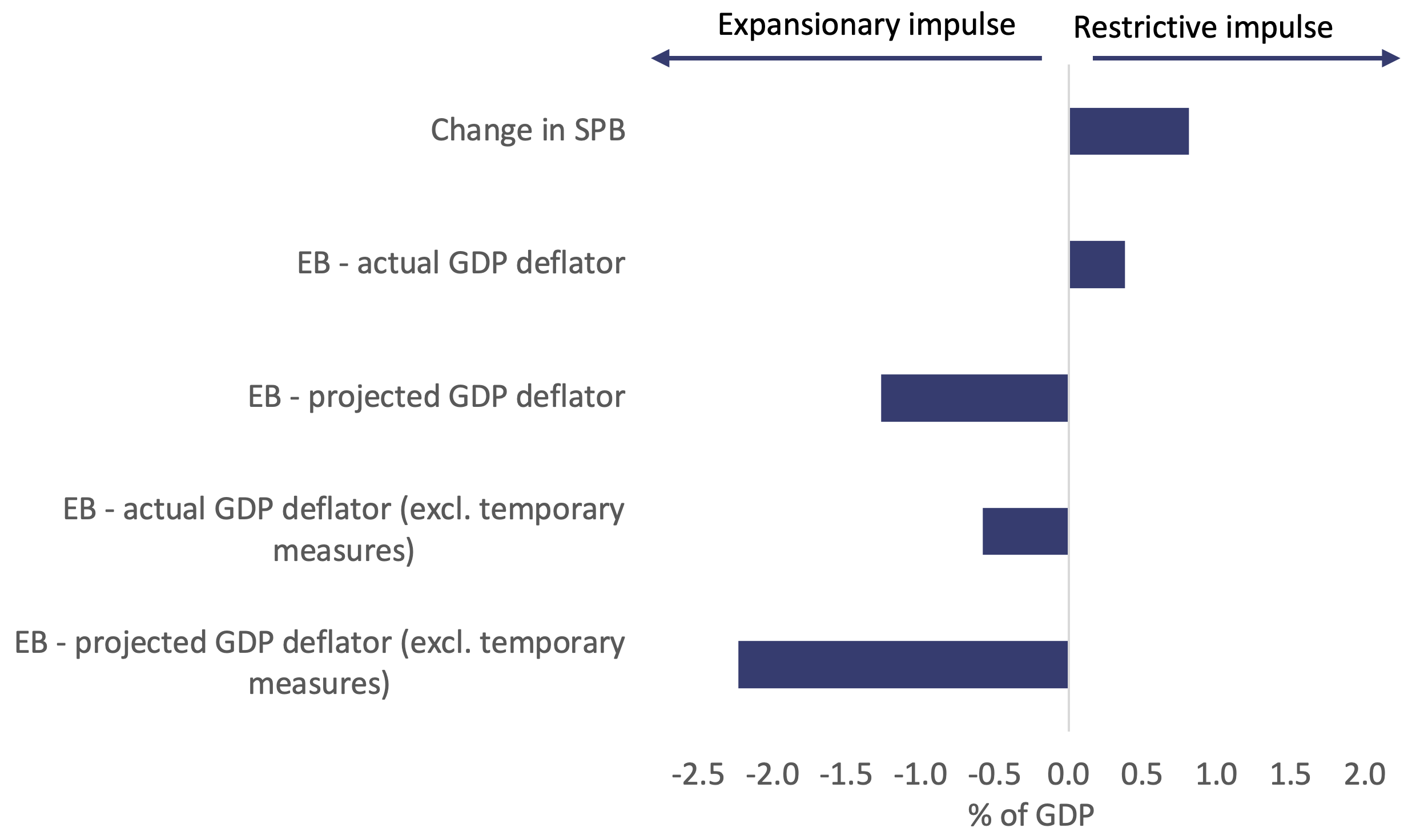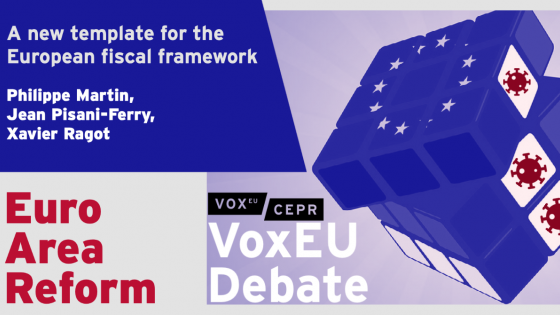Many pastry shops sell a type of cake with thick and intensely flavoured icing that masks the less promising filling made of the leftovers of an often intricate production process. The naked eye is flattered by what it sees, unbothered by the less savoury layers underneath.
This gooey image is an almost picture-perfect analogy of fiscal policymaking in the EU in 2022. Let’s start with the icing. Headline numbers of public finances improved significantly in a year where the recovery from the COVID-19 pandemic continued to power economic activity, but where the fallout of Russia’s aggression on Ukraine dealt a blow to economic prospects.
The headline deficit in the EU and euro area declined from the previous year by more than 1% of GDP, to around 3.5%, while gross government debt fell by more than 4% of GDP – the single largest drop of the debt-to-GDP ratio since the EU’s Stability and Growth Pact entered into force at the end of the 1990s. All this happened while EU governments continued winding down the massive support measures adopted during the pandemic and launched new initiatives to soften the impact of the sharp hike in energy prices on households and firms. The budgetary costs of the energy-support measures are estimated at close to 1.5% of GDP in the EU as a whole. In parallel, the structural budget balance – the headline balance net of cyclical components and one-offs – posted an estimated improvement compared to 2021 of less than 0.5% of GDP.
The official narrative around these events rightly celebrates the agility of national fiscal policies, which reacted in a timely and forceful way to two major economic shocks by means of temporary initiatives (Eurogroup 2022a, 2022b), i.e. measures that would be rolled back as soon as the triggering event was overcome.
So, on the face of it, fiscal policymakers achieved an almost impossible balancing act in 2022: they rapidly switched from fighting the economic impact of the pandemic to softening the impact of a massive terms-of-trade shock, while at the same time improving public finances. Are we witnessing a new trend that overcomes conventional trade-offs? Have we embarked on a consolidation path without expenditure cuts or revenue increases?
Scraping off the icing
The short and obvious answer is no.
The sizeable improvement in headline deficits and debt ratios observed in most EU member states in 2022 is mainly the result of favourable but transient developments, masking more worrisome underlying trends. First, the surge in inflation pushed nominal GDP growth above 8%, thereby ‘painlessly’ lowering debt-to-GDP ratios, especially in high-debt countries.
Second, soaring inflation led to temporary government windfall revenues that had a large positive impact on headline balances. Lastly, the phase-out of the massive emergency support measures taken during the pandemic alone should have led to a reduction in deficits of close to 2% of GDP.
These beneficial factors constitute temporary relief and will no longer help going forward. Revenue windfalls are expected to subside as inflation declines and no or very few COVID-19 support measures are left in the system. In parallel – and that’s the more worrisome part – underlying expenditure trends remain dynamic, especially in high- and very-high-debt countries. In 2022, net of COVID-19 and energy support measures, government expenditure advanced at a pace that exceeded that of potential output by a significant margin (Figure 1). In other words, in countries with debt-to-GDP ratios in excess of 60% or 90% of GDP, permanent expenditures grew faster than the commonly used proxy of the governments’ aggregate tax base. Unfortunately, this trend is not new: it has already been recorded in the years leading up to the energy crisis, highlighting the structural nature of the issue at hand.
Figure 1 Net expenditure growth and medium-term potential growth across country groups
Notes: The benchmark of the medium-term rate of potential GDP growth is in nominal terms. It is (a) the 10-year average of real potential output growth and (b) the year-on-year rate of change of the GDP deflator. The deflator used here is based on outturn data. Net expenditure growth (NEG) refers to the growth rate of government expenditure, excluding some items (interest expenditure, expenditure on EU programmes fully matched by EU funds revenue, and the cyclical part of unemployment benefit expenditure) and is net of discretionary revenue measures and one-offs. Investment expenditures are averaged over four years. ‘Temporary measures’ are support measures taken during the COVID-19 pandemic, energy support measures, and support for Ukrainian refugees. Differentiation of groups is based on average debt-to-GDP ratio over the period 2011–2019. Low-debt countries (below 60%) = BG, CZ, DK, EE, LV, LT, LU, MT, PL, RO, SK, FI, SE; high-debt countries (between 60–90%) = DE, IE, HR, HU, NL, AT, SI; very high debt countries (above 90%) = BE, EL, ES, FR, IT, CY, PT.
Source: European Fiscal Board, based on European Commission data.
Needless to say, the expenditure drift in high-debt and very high-debt countries does not bode well for the upcoming task of normalising fiscal policy while addressing new challenges such as the green and digital transition or strengthening security and defence. By contrast, low-debt countries grew their permanent expenditures broadly in line with medium-term growth potential over the past years and even well below in 2022.
The year 2022 also testifies to the noble ambition of governments to shield households and firms from any negative shock with fiscal policy support. Regrettably, many energy support measures were broad-based, making them excessively costly compared to the declared aim of protecting the most vulnerable (European Commission 2022: Box I.2.4). A recent study by the ECB (Amores et al. 2023) shows that while energy support measures did soften the loss of purchasing power at the lower end of the income distribution, higher-income households also benefitted from transfers or other types of intervention. Fiscal policy should not and cannot aim to fully compensate everyone for a terms-of-trade shock.
The Janus-faced nature of EU fiscal policies in 2022 – combining significant fiscal improvements on the surface with worrisome underlying expenditure trends – is best appreciated by taking a closer look at alternative measures of the fiscal impulse, i.e. the general orientation of fiscal policy (Figure 2). The two most commonly used indicators are the change in the structural primary budget balance and the expenditure benchmarks (European Fiscal Board 2023). The former gauges the direction and size of discretionary fiscal policy measures by stripping cyclical and other temporary components of the headline balance; the latter compares net primary expenditure growth to an estimate of the medium-term rate of potential output growth.
Figure 2 Euro area fiscal impulse in 2022 by different metrics (the same qualitative picture applies to the EU as a whole)
Notes: SPB = structural primary balance; EB = expenditure benchmark; temporary measures = COVID-19-related temporary emergency measures, energy support measures, and Ukrainian refugee support measures.
Source: European Fiscal Board, based on European Commission 2023 spring forecast data.
In 2022, the structural primary budget balance – as calculated by the European Commission – improved by close to 0.5% of GDP. However, this measure is polluted by the aforementioned revenue windfalls that went beyond normal budgetary elasticities. The expenditure benchmark, which cuts right through revenue windfalls, paints a somewhat different picture: it signals a much more moderate, although still restrictive, fiscal impulse, i.e. a discretionary effort on the part of fiscal authorities to consolidate. However, this is not the end of the story. There is an additional layer to be removed.
In spring 2023, when looking back at fiscal policies in the previous year, the European Commission changed the methodology of its expenditure benchmark. Instead of using the GDP deflator underpinning fiscal recommendations or budgetary plans, it applied the actual GDP deflator. Given the massive inflation surprise triggered by the energy price hike in 2022, this change has a major impact: it significantly lifts the threshold of expenditure growth considered to be sustainable in the medium and long run. In contrast, when the usual approach is followed, net expenditure growth in 2022 exceeded the medium-term rate of potential output growth by a significant margin for both the EU and the euro area. Unsurprisingly and unfortunately, the excess of net government spending was not driven by an increase in government investment but rather by current expenditure.
The Commission has repeatedly stated that COVID-19 emergency support measures are regarded as temporary and should be excluded when assessing the fiscal orientation. The same logic could be applied to energy support measures. Following this line of reasoning, fiscal policy was exceedingly supportive in the EU and the euro area in 2022, with an overall fiscal expansion of over 2% of GDP (Figure 2). This is the ‘unsavoury filling’ that will trouble fiscal policymakers going forward.
Conclusions
Recent declines of government debt-to-GDP ratios and improvements in headline balances in the EU are welcome developments, but no cause for exuberance or celebration. On the contrary, European policymakers should be wary of underlying expenditure developments, especially in high- or very-high-debt countries. The swift and significant fiscal response of EU governments to the COVID-19 pandemic first and the energy price hike after undoubtedly helped mitigate the impact of two major shocks. Now that the two big waves have largely receded, the focus needs to return to entrenched trends, which, if uncorrected, will not only affect the countries concerned. The prospective reform of the EU fiscal framework needs to carefully consider these dynamics and find the right levers to break them.
Disclaimer: The views expressed in this column are those of the authors and do not necessarily reflect those of the European Fiscal Board or the European Commission.
References
Amores, A, et al. (2023), “The distributional impact of fiscal measures to compensate consumer inflation”, Occasional Paper Series, European Central Bank, forthcoming.
European Commission (2019), “Vade mecum on the stability and growth pact”, Institutional Paper 101, April.
European Commission (2022), “European economic forecast – Autumn 2022”, Institutional Paper 187, November.
European Fiscal Board (2023), Annual report 2023, Brussels.
Eurogroup (2022a), “Eurogroup statement on the fiscal guidance for 2023”, 14 March.
Eurogroup (2022b), “Eurogroup statement on the fiscal policy response to high energy prices and inflationary pressures”, 3 October.





